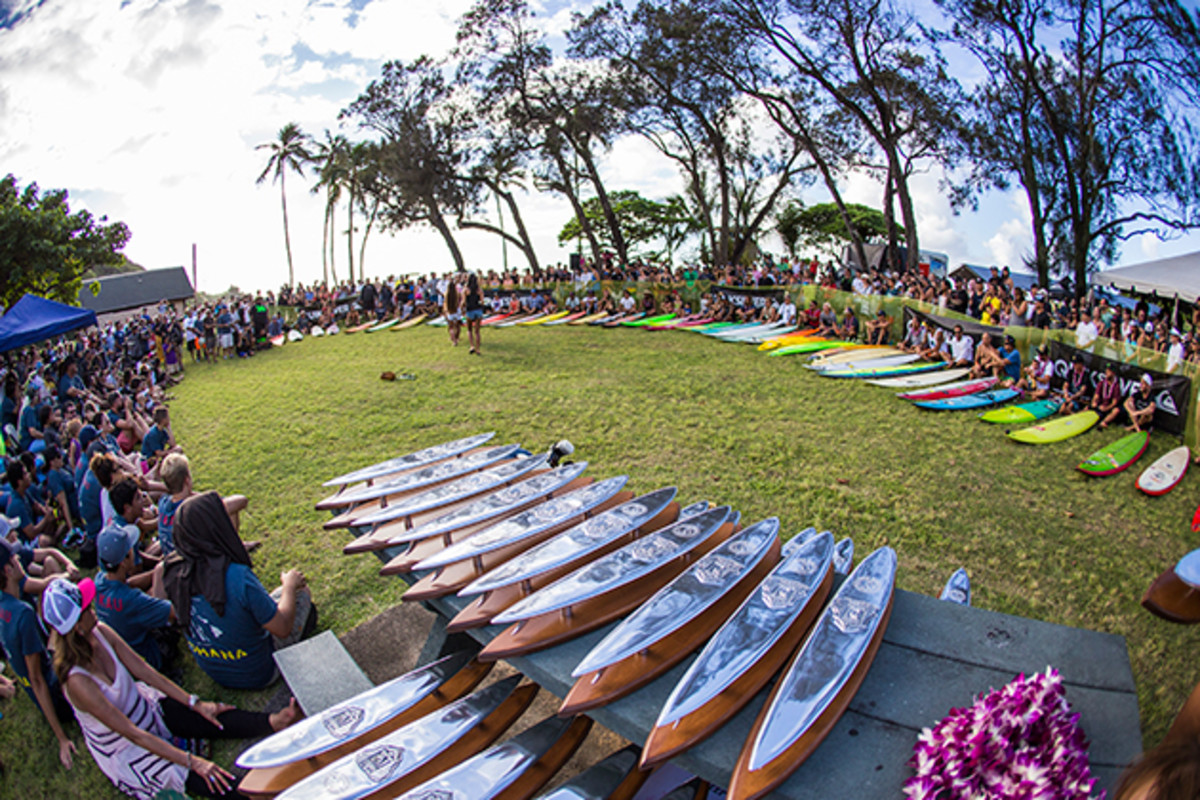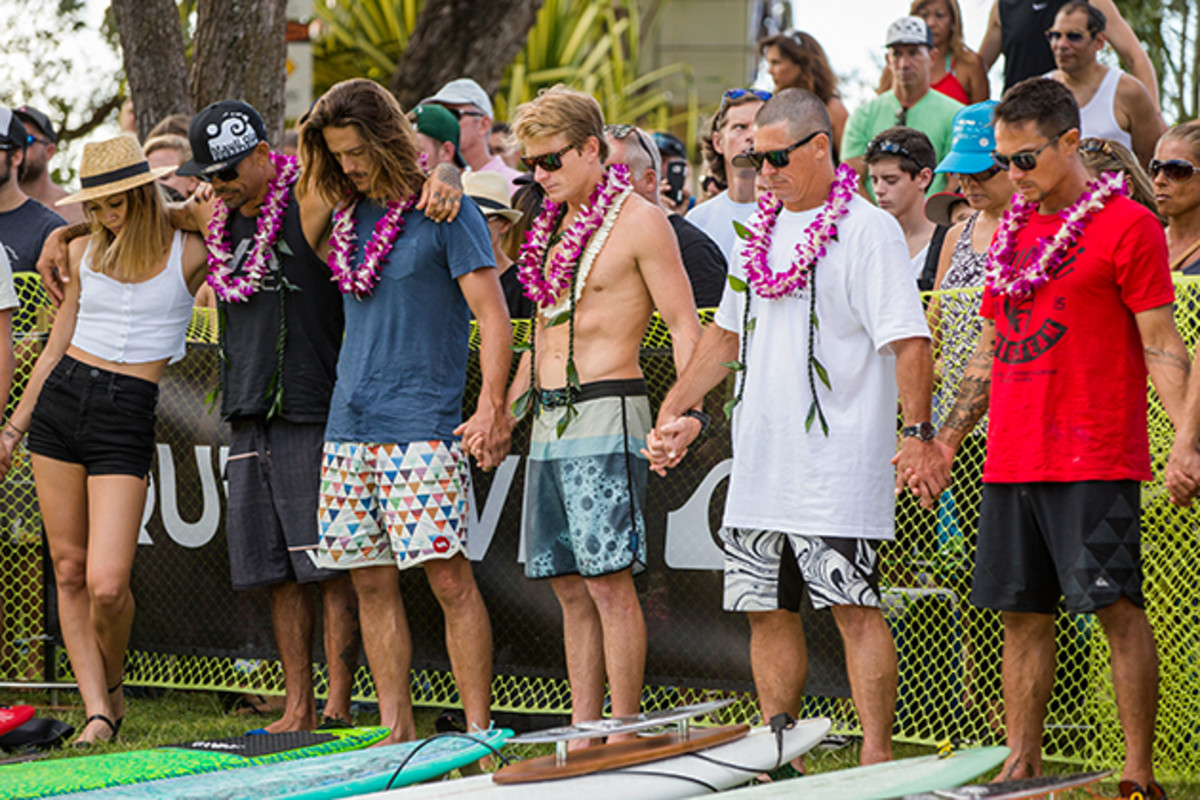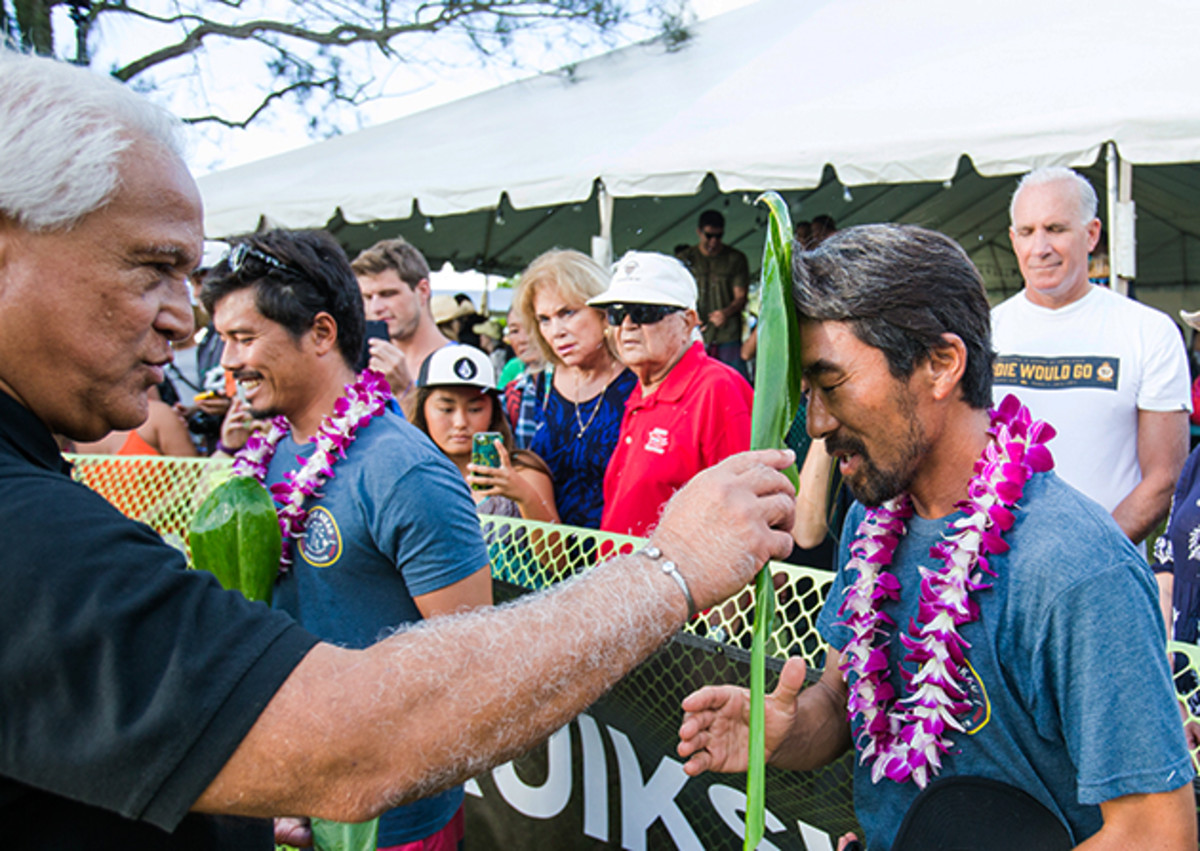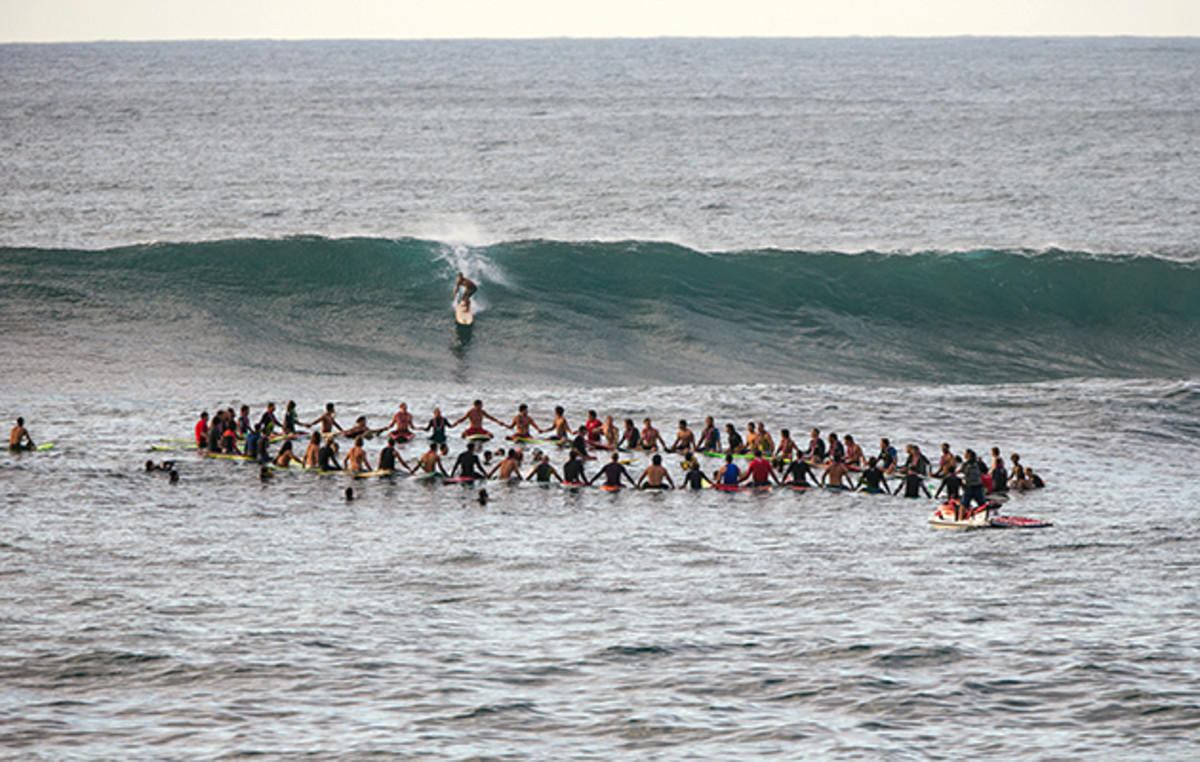Eddie Aikau's memory stays alive amongst surfing's big wave elite

The opening ceremony for the 31st Annual Eddie Aikau Invitational is running late.
It’s 3:30 p.m. on Dec. 3, a half-hour after the scheduled start, yet most of the invitees have not arrived. The air is 82 degrees and humid. A rain shower passes and offers some relief, but only for a few minutes. A crowd of a few hundred gathers on the grass above the beach at Waimea Bay on the North Shore of Oahu. They’ve come to celebrate the legacy of Aikau—the first official Waimea lifeguard, an iconic big wave surfer, and the epitome of a Hawaiian waterman.
The scene feels more like a gathering or reunion than the commencement of the waiting period for the world’s most prestigious big wave surfing contest. There are beefy Hawaiian guys that could pass for NFL linemen, towheaded kids that implore their parents to let them bodysurf in the shorebreak, and a host of pro surfers including Stephanie Gilmore, Kanoa Igarashi, and Ezekiel Lau. About every third person you meet says they’re a member of Aikau’s ohana or family.
No one seems to mind the delay.
SI Vault: The mystery behind why Kelly Slater still loves the sport of surfing
Some talk about the El Niño and the potential for massive swells. Others wonder aloud if John John Florence will attend the ceremony because he’s competing at Sunset Beach in the second leg of the Triple Crown of Surfing.
“It seems the surfers are running on Hawaiian time,” the announcer says.
They arrive in waves. The invited surfers and alternates weave through the crowd into a circle bordered by yellow plastic fencing. Kai Lenny enters, then Garrett McNamara, Tom Carroll, and Ross Clarke-Jones. This is Clarke-Jones’s 29th “Eddie” invitation—the ultimate validation for a big wave surfer. “It’s always nerve wracking waiting to find out if you’re in,” McNamara says. “The Eddie is where it all began for big wave contests so it always means more.”
A poll from 150 prominent members from the big wave surfing community, including past invitees, decides which 28 surfers earn the honor. Most must wait several years as an alternate. That list consists of 24 surfers who’d be top contenders at every other contest. But this is the Eddie. Lenny, 23 years old from Maui, is a seven-time SUP World Champion, placed second at the 2015 Ultimate Waterman Challenge, and is in the lineup during every big day at Jaws.
He’s the 13th alternate.

“I was the seventh alternate the last time they ran the contest,” says Nathan Fletcher, who won the BillabongXXL Ride of the Year award in 2012. “I was still stoked.”
All the surfers move with an easy confidence they’ve probably acquired from riding waves that can tower 50 feet overhead. While they’re exploits might seem larger than life, up close most of the posse are not hulking giants. They look more like soccer players than linebackers. They hail from as close as a mile down the road to as far away as Japan, France, and Chile. Age also does not appear to be a barrier. Fletcher is 40. McNamara is 48. Clarke-Jones is 49. Carroll, a two-time world champion, is 54. They chat about their families and how their kids are doing (Fletcher’s wife, Adela, is expecting any day), about their recent surf trips where they “scored” or “got skunked,” and about the big swell projected for the weekend.
“It’s gonna be macking,” Carroll says.
***
When the ceremony finally gets underway around 4 PM, the invitees and alternates sit in a half circle with their boards in front of them. Most of the “guns” as they’re called are over 10 feet tall and 3 inches thick with narrow, pin shaped tails. They are not designed for radical turns or aerials, but for a single task: Catch giant waves.
Lying on the ground next to one another, the boards create a palette as varied as the rainbow that appears above the mountains towards the east. Some are sea green or orange. Others are red, or checkered, or tie-dyed. A large number are neon yellow, including that of Eddie’s brother, Clyde Aikau.
Pipeline looms as a make-or-break moment for surfer Brett Simpson
Surf wax is thickly caked on top of the board, dark brown from years of use. But Aikau’s equipment is more noteworthy for what’s missing. The board does not have several stickers from sponsors like most of the invitees.
There is only one. It’s a small black rectangle with white block letters.
It reads, “Eddie Would Go."
You see those three words everywhere. On Clyde’s black shirt and trucker hat, on bumper stickers, on wooden signs along the Kam highway, even on the photographers’ media passes for the ceremony. Mark Foo coined the phrase at the inaugural Eddie event at Sunset Beach in 1985, when the contest directors debated postponing the contest. They thought the 20-foot surf was too big. Foo disagreed. “Eddie would go,” he told them. The contest was on.
The next year, Quiksilver enlisted George Downing as the contest director. Change ensued. Downing, a pioneering surfer and board builder on the North Shore in the 1950s, was pivotal in relocating the Eddie to Waimea and instituted strict requirements on the size and quality of waves necessary.

. “We decided that we would not run it unless [the waves were] 20-foot Hawaiian.”
That’s a misnomer. A 20-foot “Hawaiian” wave has a face that’s more like 40 feet. Conditions that big are rare occurrences, even on the wave-rich “seven-mile miracle” of the North Shore during the waiting period from Dec. 1 to the last day of February. Six years have passed since the last event—won by Greg Long of San Clemente, Calif. Kelly Slater is the second most recent winner—his victory was in January of 2002.
In 31 years, the contest has been held eight times.
***
For Clyde Aikau, Eddie Would Go, carries a meaning beyond his brother’s surfing prowess.
“Eddie was a real humble and giving person,” Clyde says. “He put nearly every person before himself and was all about helping people.”
That trait was most evident after Eddie became the first official lifeguard at Waimea Bay when he was 22 in 1967. Clyde joined him two years later.
The figure that clings most to Eddie’s image, and the one that Clyde often reiterates, is not the 500 rescues Eddie made, but the number of people he failed to save.
Zero.

In 1978, Eddie volunteered for the Polynesian Voyaging Society’s 30-day, 2,500-mile journey from Oahu to Tahiti on the Hokule'a: a 62-foot, double-hull sailing canoe. The route followed that of the early Polynesian migrants. The vessel embarked from Magic Island on Mar. 16 at dusk. However, around midnight, 12 miles into the voyage, the vessel capsized. The crew clung to the hulls. Aikau did not. He started paddling his surfboard. His goal? Secure help by reaching the island of Lana’i, close to 20 miles away. The U.S. Coast Guard found the Hokule’a and rescued all of the crew. Except for Aikau. Despite an extensive search, he was never found. He was 31.
***
Back at Waimea there is a display with several pictures of Aikau, though in each his gaze is not focused on the camera. He stares out at the ocean.
During his speech, Clyde, 66, reveals that this will be his last year as an invitee. He won the contest the first year it moved to Waimea on his brother’s favorite board.
“It is passion that kept me going all this time,” Clyde says while trying to fight back tears. “I still have that drive and that passion to catch one more big one—I hope to make by brother Eddie proud.”
SI Vault: The beloved Duke of Waikiki, from the Olympics to surfing stardom
After a pastor blesses each of the surfers with ti leaves and water from the ocean, everyone walks down the beach. They paddle out and form a circle a few hundred yards out on the edge of the break. Aikau is in the middle.
Waves break along the rocky point at the right end of the bay, creating what seem like small mountains of whitewater. The surf is double overhead—big, but not exceptional by elite standards. A handful of surfers sit in the lineup. One turns and paddles for a set wave. The crowd cheers. He pops to his feet, but nosedives and wipes out. Ouch! Several fans shout in unison.
Some of the invitees stand out in the circle because of their bright red, short-sleeved wetsuit vests. The tops are for more than looks. They are the latest prototype of the Quiksilver x Aqualung Inflatable Ocean Safety vest. The vest is the result of two years of research and development from Quiksilver and Aqualung—the leading manufacturer of diving equipment like buoyancy compensators and alternate air sources. With a pull on one of the four red tabs, CO2 cartridges fill the vest’s three air bladders and propel the distressed surfer to the surface.
“Just like you want to select the safest car for your family, I want to have the safest product possible so I can come back to my family after I surf,” says Jamie Mitchell, an Eddie invitee and Quiksilver-sponsored surfer who tested the vest at several big waves spots like Jaws. “When I put that thing on there is absolutely no doubt in my mind that it will work and save my life if I need it to.”

Quiksilver offered the IOS vest to all the invitees. Eighty percent said they’d wear it in the contest.
Still, the vests are also a reminder of the inherent risks of the sport. Alec Cooke, 59, a standout in larger surf who once jumped out of a helicopter in 1985 to catch waves at the outer reefs of Pipeline, paddled out at Waimea on Tuesday, Oct. 27—the first big swell of this season. Cooke’s girlfriend reported him missing on Wednesday after he did not return home. On Thursday, his truck was found next to the church on the point at Waimea. The Coast Guard launched a search that was extended for four days. They did not find Cooke.
Out in the circle, Clyde Aikau asks for 30 seconds of silence for Cooke—their “brother.” That was not the only alteration in the proceedings. In year’s past, Clyde would select a couple of the invitees to speak to the group. Now, every surfer introduces himself and explains the motivation and drive that helps him tackle big waves. Florence included. He made the final at Sunset, but rushed over after the awards presentation so he could participate in the Eddie celebration. Florence would paddle out with the invitees when he was still a pre-teen and dreamed of receiving an invitation to “the Wimbledon of surfing” as McKnight calls it. That fantasy turned into reality in 2012.
Aikau continues his address, but he cannot quell his own love for his brother, this event, and this place. He struggles to contain his emotions. So do others. “I was really humbled when a lot of the big macho big wave riders told me ‘you put a tear into my eye,’ Aikau says later in the evening.
The surfers throw the ti leaves and leis into the air and splash the water. You can hear their hoots from the shore. Most then paddle over to the point and catch waves into the beach. They make the surf look playful. Back on land, they trod through the deep sand and are greeted by family and friends, or in Florence’s case, beset by photographers, children asking for autographs, and older fans looking for photos with the young surfing legend.
The sun sets in an orange burst.
Some surfers stay for a barbecue and concert, but many head to the parking lot and stash their boards in their SUVs or trucks or strap them to the roof. They disappear into the night.
Now the real wait begins.
